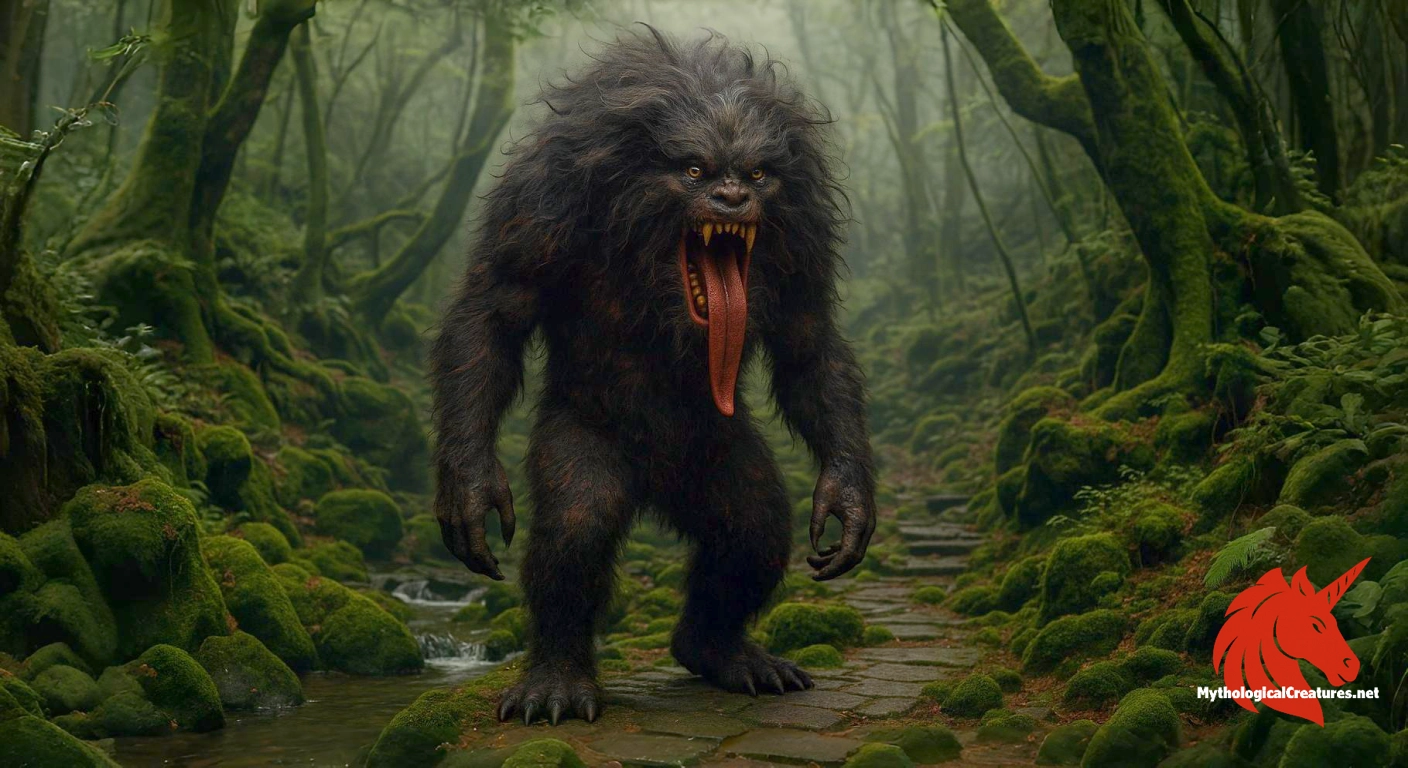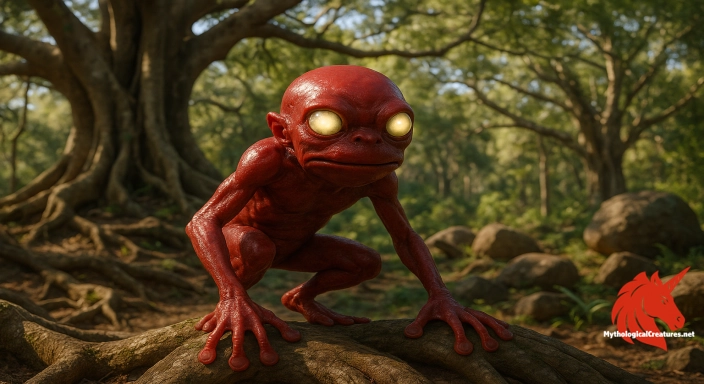Akashita: Akashita is a Japanese yōkai from the Edo period, depicted as a beast with clawed hands, a very hairy face, and a strikingly large red tongue.

Akashita
Akashita - Noted for its distinctive red tongue and enigmatic portrayal, Akashita is an exemplary figure in Edo period folklore.
Origins & First Encounters
Akashita, whose name translates as 'red tongue,' emerges from the enigmatic world of Edo period folklore and artistic emaki. It originated at a time when Japan’s creative minds interwove the natural with the supernatural, crafting images of beings that defied ordinary explanation. This yokai is steeped in mystery, its presence captured in delicate scroll paintings that evoke both beauty and the uncanny. Often identified interchangeably with Akaguchi, the creature’s dual identity hints at a rich tradition of evolving myth. Its depiction reflects a period when visual artistry celebrated the fearful yet fascinating aspects of the unknown. The artistic tradition of the Edo period granted Akashita a timeless allure that stimulates both scholarly inquiry and popular imagination. Its distinctive red tongue has become emblematic of a broader cultural fascination with extraordinary physical traits in myth. The lore surrounding Akashita thus symbolises a bridge between historical artistry and the enduring spirit of Japanese myth.
Source Texts & Tale Variants
Primary depictions of Akashita are found in Edo period yokai emaki, where its mysterious form is rendered with bold strokes on ancient scrolls. Notably, works such as Bakemono no e provide the earliest visual records of this spectral being. The lack of detailed explanatory notes by artists like Sekien has left enthusiasts to piece together its myth from suggestive imagery rather than explicit descriptions. Its alternate designation as Akaguchi further complicates the narrative, blending together multiple strands of folklore. Variations in the artistic presentations have sparked a diversity of story variants, each echoing different nuances of its nature. These scrolls capture the creature’s defining characteristics, making clear the emphasis on its red, protruding tongue and clawed appendages. Subtle discrepancies in various manuscripts encourage a dynamic interplay between visual art and oral tradition. Consequently, the creature’s early attestations continue to foster debate among folklorists and art historians alike.
Form & Powers
Physically, Akashita is depicted with a set of clawed hands, evoking both a sense of menace and primal vitality. Its face is rendered with an abundance of unruly hair that melds with the imagery of dark, rolling clouds, lending an air of mystique and foreboding. The creature’s most arresting feature is its conspicuously red tongue, which dominates its open mouth in a dramatic fashion. Although its complete body form remains shrouded in mystery, existing portrayals suggest a being that blurs the line between human and beast. Artists employed imaginative techniques to capture an ephemeral quality through shadow and movement, hinting at a fluid, almost shifting appearance. Varying depictions underscore its potential to change size and form, a trait that adds to its spectral ambiguity. The interplay of stark, contrasting colours emphasizes both danger and allure, inviting viewers to contemplate deeper symbolic meanings. In sum, the physical portrayal of Akashita is as much about aesthetic exuberance as it is about evoking an enduring sense of uncertainty in the observer.
Regional Faces
Regional interpretations of Akashita reveal a fascinating tapestry of local adaptations and narrative nuances. In certain parts of Japan, the creature is seen as a portent of inclement weather, its dark cloud-like facial hair interpreted as a reflection of turbulent skies. Rural communities occasionally imbue it with a role that blends mischievous spirit with an almost protective guardianship over nature. Local artisans and storytellers have introduced subtle alterations, focusing on different facets such as the prominence of its clawed hands or the supernaturally vibrant red tongue. These regional variations allow the creature to embody varied thematic roles—from an omen of misfortune to an enigmatic guardian. Cultural festivals and local legends further adapt its image to resonate with regional sensibilities and environmental metaphors. The diversity of these portrayals enriches the overall mythos, blending a shared national heritage with local colour and flavour. Ultimately, the regional perspectives on Akashita exemplify how folklore morphs to reflect the distinct cultural landscapes across Japan.
Cultural Parallels
The figure of Akashita shares compelling parallels with supernatural entities across a range of cultural traditions, inviting deep comparative exploration. Similar to certain European legends where monstrous features symbolise inner human fears, Akashita’s exaggerated red tongue and clawed hands evoke a potent mixture of dread and fascination. Its alternate naming as Akaguchi echoes the common folkloric motif of shapeshifting and ambiguous identity, a theme prevalent in many mythic tales. When placed alongside other Japanese entities like the Oni or Tengu, Akashita stands out through its unique combination of natural and spectral elements. The integration of intense, almost otherworldly hues and fluid physicality parallels descriptions found in other folk traditions that celebrate the abnormal and the uncanny. This yokai also resonates with aspects of animalistic symbolism in comparative mythology, where distinctive features serve as metaphors for duality and inner conflict. The interplay between its fearsome appearance and its underlying mystery invites a broader dialogue on the use of bodily exaggerations in myth to reflect societal taboos. Across cultures, such visually striking traits often become a conduit for exploring fears deeply embedded in the collective psyche. In this way, Akashita not only mirrors but also enriches the cross-cultural narrative of mythological beings with complex, layered symbolism.
Legacy & Modern Evolution
The evolution of Akashita from an obscure figure in Edo period scrolls to a subject of modern reinterpretation reflects the dynamic nature of myth-making in Japan. Initially captured on delicate emaki and celebrated in the detailed works of traditional artists, its enigmatic features have ensured a lasting legacy. Over time, the creature has been revitalised in modern media, with manga, anime, and digital art drawing upon its mysterious qualities. Contemporary portrayals continue to emphasise the drama of its red tongue and the dark symbolism of its cloud-like visage. As modern artists and storytellers reimagine these traditional designs, the inherent ambiguity of Akashita opens up endless possibilities for reinterpretation. Its dual identity, both as Akashita and Akaguchi, reinforces a narrative flexibility that appeals to diverse audiences. Present-day cultural festivals and exhibitions also celebrate its enduring presence as a powerful icon of Japanese folklore. This ongoing evolution illustrates a broader trend where ancient myth meets modern aesthetic, ensuring that the legacy of this yokai remains as vibrant and provocative as ever.
Interesting Fact
An interesting aspect of Akashita is its dual identity as both Akashita and Akaguchi, highlighting the fluid nature of yōkai nomenclature and regional artistic interpretations in Japan.
Quick Creature Info
Features:
Our Mythic Legendary Rating:

Also Sometimes Known As:
Habitat:
Supernatural Powers:
Physical Attributes:
Abilities:
Behavior:
Lore:
References
Discover Another Mythical Legend You May Not Have Heard Of?
Uncover the mysteries of ancient folklore and expand your knowledge of legendary beings from cultures around the world.
Dare to Meet the Yara-ma-yha-who....
Curated by the Mythological Creatures Team (rev. May 2025)
